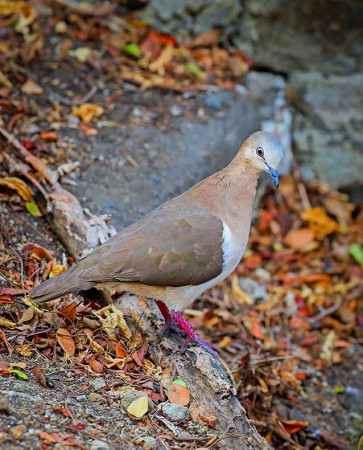
Listening along the hillsides of the Mt. Hartman Estate, you can hear the mournful call of the Grenada Dove, one of the world’s most critically endangered birds. It is a shy and elusive bird, staying well within the forested hills and valleys of the estate, and very rarely seen outside of the forest canopy. The Mt. Hartman Estate, one of only two locations in the world where this bird lives, has been transformed over the last few years into one of the region’s premiere education and outreach centers, focused on the Grenada Dove.
The Grenada Dove is brown with a white belly, a light pinkish brown upper chest and neck, and a grayish forehead that extends up from the bill. Its legs, feet and bare skin around the eyes are a bright crimson red. The adults show a white belly, no markings on wings, outer tail feathers tipped with white, and a strip of white feathers that extends from its side up around the bend of the wing.
Though rarely seen, male Grenada Doves call for long periods during the breeding season with a single, descending note about a second in duration that is repeated every seven to eight seconds and can be heard up to 100 metres away. Because of the topography of the Grenada Dove’s habitat, calling males from the hillsides can be heard in valleys outside of dove habitat.
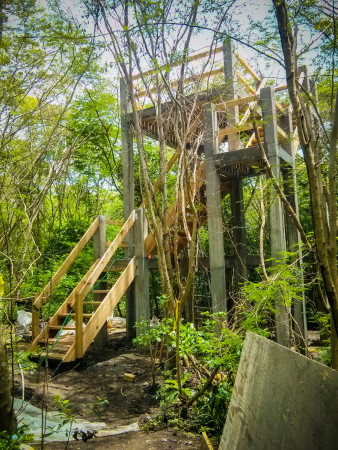
Habitat loss and predation by introduced invasive species such as mongoose, rats and cats are the primary threats facing the dove. Not having evolved with these introduced ground predators and sensitive to direct disturbance, a dove flushed from a perch will fly to the ground and attempt to run away, making them easy prey. Like most doves, the Grenada Dove spends most of its time scouring the ground for seeds. Although nests are located in trees, these are easily preyed on by rats. Nestlings shift to the ground at about 14 days old, making them as well as adults easy prey on the ground.
These habits continue to place the dove at risk. With funding from American Bird Conservancy and the Mohamed bin Zayed Species Conservation Fund, the Grenada Dove Conservation Programme and the Forestry and National Parks Department began to implement predator control programs at both the Mt. Hartman National Park and Perseverance Protected Area and Dove Sanctuary in 2013. Very high numbers of predators were caught at both sites—more mongoose at Mt. Hartman than Perseverance, but more rats at Perseverance—and it is well understood that continued predator control is urgently needed. Due to limited funding, control has been limited to key breeding areas. A predator-proof fence would provide the best protection, but financing for this endeavor has not yet been secured.
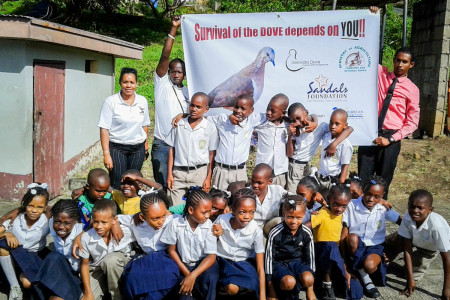
Starting late in 2013, the Grenada Dove Conservation Programme and the Forestry and National Parks Department have been working to make it easier to hear, see, learn about, and appreciate Grenada’s unique endemic National Bird and its habitat, the dry coastal forests of Grenada and the Mt. Hartman National Park. Through a generous grant from the Sandals Foundation, and with additional help from BirdsCaribbean, the Critical Ecosystem Partnership Fund and the US Fish and Wildlife Service, they have created new interpretative displays at the Mt. Hartman National Park and Visitor Center, developed outreach materials targeting the broader public, and carried out a school programme for elementary students in the Parish of St. George’s about Grenada’s unique species, the Mt. Hartman National park.
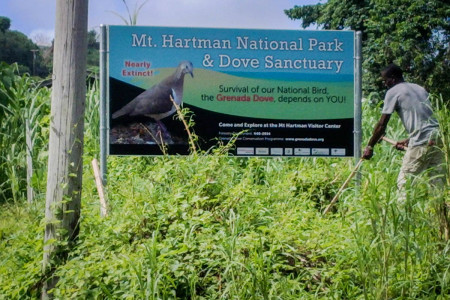
Initial activities in this project began with the pro-bono assistance of wildlife photographer, Greg Homel. He captured gorgeous photos of the dove that enabled us to include enlarged images on our outreach materials, including billboards at all parish boundaries island-wide. Though easily heard with a distinct call, the Grenada Dove is difficult to see in the forest. The idea was to bring the dove to Grenadians, residents and visitors alike on their daily commutes.
After Hurricane Ivan in 2004, funds allocated for interpretation at the Mt. Hartman Visitor Center from the GEF/World Bank funded Grenada Dry Forest Biodiversity Conservation Programme needed to be reallocated for the complete rebuilding of the Visitor Center at Mt. Hartman. The activities carried out by the Grenada Dove Conservation Programme, with the Forestry and National Parks Department, enabled us to supplement existing interpretation at the site, including building a 20ft viewing tower surrounded by dry forests, at the edge of Grenada Dove habitat. Being still and with patience, one may see this elusive bird! The tower’s location enabled visitors to hear calling doves, and experience the dry forest and its wildlife, including anoles, birds and lizards. At the entrance to the short trail leading to the tower, an outdoor bird identification display featuring Grenada’s bird species has been erected that identifies endemic, resident and migratory birds. BirdsCaribbean provided the template.
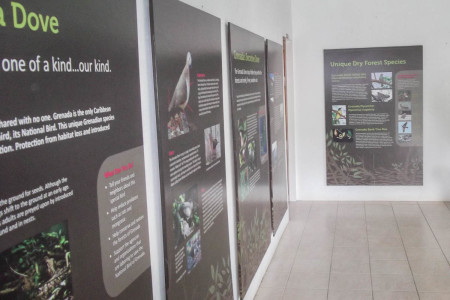
Multiple 8-foot tall indoor wall displays in the Mt. Hartman Visitor Center tell the Grenada Dove story in a larger than life fashion. With numerous descriptive photos and information, both youth and adults are targeted. These displays cover the dry forests, the dove itself, its habitat and threats. At child height, the 8 sq. ft. tabletop 3D relief map shows visitors the hills and peninsula that make up the Mt. Hartman National Park.
Posters, stickers and a brochure full of pictures on the Mt. Hartman National Park and its wildlife were designed and printed, both for display island-wide in government buildings, schools and tourist establishments as well as for distribution to students in our school outreach programme. Having developed an elementary school presentation, Forestry and National Department staff visited over 20 schools, and are continually getting called to present to more grades and schools island-wide.
The Project’s goal is to bring more students and visitors to the Mt. Hartman National Park to experience Grenada’s forests and unique biodiversity first hand.
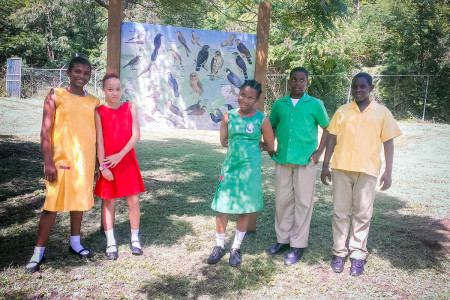
The Grenada Dove, IUCN listed as Critically Endangered, is found only on the island of Grenada. With a total population of around 160 individuals*, it is one of the rarest birds in the world. Found only on 2 locations on Grenada, its population is declining primarily due to loss and degradation of its specialized habitat and predation by invasive predators such as mongoose and rats. The Grenada Dove Conservation Programme, in collaboration with the Forestry and National Parks and international collaborators for the last 20 years, is working to keep this unique species from extinction through habitat protection, research, species management, stakeholder participation, and education.
By Bonnie Rusk, Founding Director, Senior Biologist at Grenada Dove Conservation Programme
Visit this page to learn more about the Grenada Dove and download free educational resources:

Great Work Bonnie!!! Congrats
Thanks Paulo, I will convey your message to Bonnie!